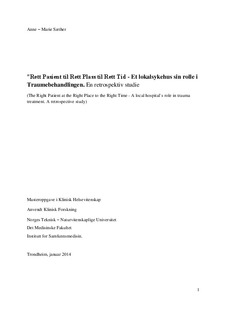| dc.description.abstract | Background: There is a debate in many countries regarding the role of smaller hospitals in
the treatment of trauma victims. This is a retrospective study of 4 30 trauma victims received
at a district hospital in Norway over a 6-year period. The hospital has 179 beds and serves a
population of 92000. A system for regular trauma team (TT) training and recording of the
work is in place. The regional Trauma Centre is located in Trondheim 80 km away. The
purpose of the investigation was to study the magnitude of trauma work as well as the quality
of the diagnostic, anesthetic and surgical work done at the local hospital and the cooperation
with the Trauma Centre.
Methods: With approval of the Regional Ethics Committee we have studied the recorded data
from 430 traumas with TT activation as well as hospital records of the most severely injured
patients. We have specifically studied patients having emergency procedures such as airway
control, chest drainage, and emergency haemostatic surgery and patients who were
transported to the Trauma Centre.
Results: During the 6 years 430 trauma patients were received at our hospital. During the
same time period 334 patients were received at another small hospital in the county (Namsos)
and 286 patients were transported directly to the Trauma Centre with helicopter. This means
that 74% of the trauma patients were received at the two local hospitals. The last year, 71% of
trauma victims in our catchment area were received at the local hospital. Only 27 patients had
advanced x-ray diagnostics and a total of 20 had either immediate airway control, chest
drainage or immediate surgery, 12 patients were sent to the Trauma Centre after initial
stabilization. In some cases the emergency work at the local hospital was clearly life saving.
Using ISS 15 as a cut off value, the over-triage was 91%.If we use ISS 9 as the cut off value,
the over-triage was 72%
Conclusion: The investigation clearly shows the importance of the local hospital in the chain
of treatment for trauma victims. This is particularly important in a country with poorly
weather and long distances. The main challenge in the future is to fine-tune the triage systems
to make sure that the right patients go directly to the Trauma Centre, and to maintain the
training and expertise at the small hospital to compensate for the lack of patient volume. | nb_NO |
